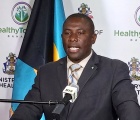The Bahamas became a signatory to the Convention on Biological Diversity in December of 1993. Upon the signing of the convention The Bahamas recognized that biodiversity is about more than plants, animals and microorganisms and their ecosystems. We recognized that biodiversity is about people and our need for food security, medicines, fresh air and water, shelter and a clean and healthy environment in which to live.
Protected areas constitute an important stock of natural, cultural and social capital, yielding flows of economically valuable goods and services that benefit society, secure livelihoods, and contribute to the achievement of the Millennium Development Goals. Moreover, protected areas are key to buffering unpredictable impacts of impending climate change. As a low-lying archipelagic ocean-nation, The Bahamas is mindful of the effect that sea level rise and climate change will impact our way of life and survival if immediate and significant global action is not taken.
The Bahamas is doing its part and has continued to be a leader in the arena of protected area designation. Beginning in 1958 with the creation of the first land and sea park in the world – the Exuma Cays Land and Sea Park, the doubling of the protected area system in 2002 as well as the identification by the Department of Marine Resources of 39 areas for a marine reserve network, our country has continued to recognize the value of protecting natural resources for the benefit of Bahamians today and in the future.
The Bahamas in 2008 announced its acceptance of the Caribbean Challenge Initiative (CCI) and reaffirmed the country’s commitment to protect 20% of its near shore and marine environment. The Bahamas is part of a group of 10 Caribbean nations that have joined the CCI committing to protecting at least 20% of their marine environments by 2020. Today, as the current Co-Chair of the CCI Council and Minister responsible for the Environment, I am here to announce with great pride and a sense of accomplishment that we are progressing steadily towards this target.
In recent years, the government of The Bahamas, through my Ministry, the Bahamas Environment Science & Technology Commission and a dedicated team of conservation professionals from the Bahamas National Trust, The Nature Conservancy, and the Bahamas Department of Marine Resources, supported by funding from the United Nations Environment Programme (UNEP) and the Global Environmental Facility (GEF) have been implementing a full sized project that includes as its final goal, the expansion of the marine protected area system of The Bahamas. The project sets as its target the protection of 2.5 million hectares. These new areas have undergone scientific assessment and extensive community outreach.
The new additions to our protected areas system are:
In Abaco:
- The Marls of Abaco National Park
- East Abaco Creeks National Park
- Cross Harbour National Park
- South Abaco Blue Holes National Park
In Crooked Island / Acklins:
- Southeast Bahamas Marine Managed Area
- Bight of Acklins National Park
In Andros:
- Andros Green Cay National Park
- The Joulter Cays National Park
- The Cay Sal Marine Managed Area
In Grand Bahama:
- The North Shore – The Gap National Park
- East Grand Bahama National Park
- Lucayan National Park Expansion
- Peterson Cay National Park expansion (further consultations are being held with the key Grand Bahama Stakeholders)
(All Grand Bahama Parks exclude Grand Bahama Development Company holdings)
- Hogsty Reef Protected Area
In Mayaguana:
- Booby Cay National Park
In New Providence:
- Southwest New Providence Marine Managed Area
- Perpall Tract National Park
In Great Exuma:
- Expansion of Moriah Harbour Cay National Park.
These new areas will conserve and protect habitat for Grouper and Bonefish spawning aggregations, coral reefs, sea grass meadows, mangrove nurseries, and important bird areas.
As well as the creation of these new protected areas, the government of The Bahamas realizing the cost of managing protected areas increased its subvention to the Bahamas National Trust in the 2015 budget. Additionally as part of the Global Environmental Facility Full – Sized Project “Building a sustainable network of marine protected areas for The Bahamas “ a mechanism for sustainable financing, the Bahamas Protected Area Fund, has been legislated and implemented. I am advised that The Bahamas is the first country to enact legislation establishing a legal trust fund dedicated specifically to financing protected areas management.
In our Charter for Governance, the current administration committed to safeguarding and protecting our nation for future generations, including the preservation of our environment. Today, we have set the foundation for the protection of approximately of 7.5 million acres (3 million hectares) of land, nearshore and marine environment. This includes the new San Salvador National Parks announced in April of this year and in total exceeds the target of 2.5 million hectares set for our GEF Full-sized MPA project, thus achieving the protection of 10% of our nearshore and marine environment. This major achievement and commitment moves us closer to our national goal of protecting 20% of our near shore and marine environment by 2020.
To allay any concern regarding land rights associated with the Marine Protected Areas network, it should be noted that all private land will be excluded from the boundaries of the protected areas and the rights of landowners will not been infringed upon. With respect to public land, they will remain under the control of the Minister responsible for Lands.
The Ministry will now work with and consult our partners, stakeholders and local communities to develop the management plans associated with these declared areas. Some areas may be “managed conservation areas” and others may be “no take zones”. There is much work to be done in this regard and simultaneously we will set in motion, efforts to achieve our 20% commitment. All of these efforts are a part of our goal of developing the green and blue economies of The Bahamas.
We will spare no effort to ensure that we achieve this lofty but attainable goal for the benefit of both current, but especially future generations of Bahamians.





